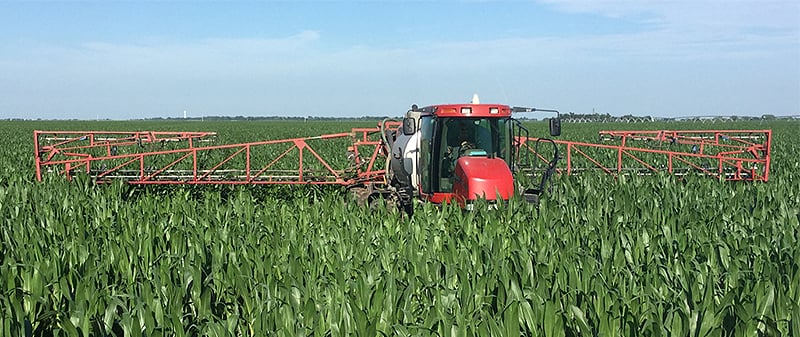When it comes to nutrient management, Deweese, Neb., farmer Brian Herbek lives by the 4R philosophy.
As a fifth-generation farmer on a dryland and irrigated 1,900-acre corn and soybean operation, he’s focused on slowly evolving his practices over the years to become more efficient. After trying ridge-tilling, conventional tilling and no-tilling, he eventually hit on strip-tilling in 2009 and hasn’t looked back.
“I tried it on about one-third of my acres and by that fall, we saw some the benefits and went to 100% of our acreage the next year,” says Herbek. “We got the stands and yield we wanted, but a lot of what convinced us was the reduced time and manpower needed in the fields.”
With freed up time and targeted tillage, Herbek began to focus on nutrient management. With the right strategy, he was confident he could save money on inputs, conserve moisture and improve soil health.
“I’ve been able to move my nitrogen (N) efficiency from 1.1 pounds of applied N to the bushel-per-acre to below a 0.7 on my best fields,” he says. “A lot of that is due to the split applications I’m doing, and as my soil health improves, I find my fertilizers becoming more and more available throughout the growing season.”
Herbek shares some nutrient management tips that have helped him make more efficient use of his inputs:
1. Soil Sample Often
To ensure efficient use of fertilizer and nutrients, it’s best to understand what’s happening in the soil itself. Herbek is a firm believer in developing an extensive sampling protocol.
“We’re sampling in multiple places in the field,” he says. “To get our consistency, we sample 4 inches off the growing plant when we’re doing the in-season sampling. During post-harvest sampling, we’re going in where we’re going to plant next year’s crop. We’ve got to know what’s going on in each field and then what’s going on with each zone in that field.”
Logistically, Herbek says it has been difficult to sample his fields with a 2-acre grid system, so he’s adopted a “zonal approach.” Combining satellite imagery, harvest data, soil types and test results, he has growing confidence that he understands the demand of his zones. Timing is still tricky though.
“We have to do it right at harvest — I mean as soon as the combine has gone through the field, we’re out there poking holes,” he says. Herbek is sampling 15 inches off the old corn row because that’s where he’ll be building his strips.
“We like moving over because we don’t want to disturb the old root ball,” he says. “We like leaving it there for the worms to feed on and it seems to help with compaction.”
2. Spoon Feed Crops
Herbek believes he’s unlocked efficiencies by splitting nutrient applications. Each application is variable-rated, based on soil samples pulled for each “zone,” he says. To start, he does a fall and spring strip-till pass with his dual coulter 12-row Environmental Tillage Systems Soil Warrior.
“During our fall pass, we apply all of our non-leachable nutrients — our potassium (K), phosphorus (P) and we put some zinc and sulfur out too,” he says. “While we’re doing that, we’re trying to incorporate as much residue as we possibly can to help with the erosion. That helps residue break down so we have those tied up nutrients become available for next year’s crop.”
In the spring, Herbek freshens his strips while putting out his base rate of N in a dry urea product. This is anywhere from 50-125 pounds per acre depending of his yield goals and soil tests, he says.
The timing for this is also important, because he doesn’t run any extra N through his planter. Instead of applying starter fertilizer, Herbek says he recently installed liquid fertilizer tanks on his strip-till rig to dribble pop-up fertilizer and a micronutrient package while he’s freshening the strip in the spring.
“Typically, we’re trying to do this a few weeks prior to planting because we want to see some of that N break down and be available for the plant,” he says.
From there, he sidedresses N as needed throughout the growing season and comes in late with a round of N through 360 Yield Center Y-drops. Based on soil samples, this can be anywhere from 15-50 extra gallons of product per acre.
3. Mind the Micros
Herbek says micronutrients have been one of his limiting factors according to tissues tests and soil samples. Working with his agronomist, he assembled a micronutrient “concoction” of mostly boron, molybdenum, manganese, copper and zinc to dribble out of his newly custom-fabricated and installed liquid tanks of the strip-till rig.

Y-Dropping. Brian Herbek is a firm believer in split applications. In the fall, he places “non-leachables” like P, K, zinc and sulfur. In the spring, he’ll refresh his strips, place his base N in dry urea and micronutrients. From there, he’ll sidedress as needed and run from 15-50 gallons (depending on need) of N through Y-drops in a late season application.
“The number one thing we were deficient on was boron,” he says. “It’s a huge element, we’ve got to watch what we’re doing with it. Agronomists say that most farmers throughout the country are deficient in it, especially on fields with higher corn yields. When you’re getting to that 250-300 bushel mark, you need to focus on it.”
Again, timing is a factor and for Herbek. When to apply the boron is still a work in progress, he says. “For about 2 years, we were applying boron through Y-drops later in the growing season and we saw some of our best corn,” he says. “But in 2019 we’re doing some side-by-sides. We dribbled some in the strips pre-plant and put some through the Y-drops again.”
4. Get Deep
With Herbek’s dual coulter system, he’s able to put nutrients down about 7-8 inches — but, the deeper the better, he says.
“We’re looking into a different set up to get the nutrients even deeper in the profile,” says Herbek. “Often, it seems farmers are ending up with the majority of their nutrients in the top 3 inches of their soil. We really want to get deeper, especially in the dryland acres, so we can get the nutrients down to where the roots are actively growing.”
Testing a Micronutrient Mix
Hear more from Deweese, Neb., strip-tiller Brian Herbek on how he custom-fabricated and installed 2 liquid tanks on his strip-till rig to apply a micronutrient package. Visit www.StripTillFarmer.com/Herbek.
As important as depth, is distribution, Herbek adds. His dual coulters allow him to place nutrients and fertilizer in the strip without creating “hot zones.”
“My strips are about 9 inches wide and 7-8 inches deep,” he says. “That fertilizer is in that entire zone — there are no hot spots. Some of the machines are putting down a concentrated band and that may be creating what I’ve heard called a ‘lazy root.’ This is when the roots get into the band and is just happy there so they don’t stretch out and search. That’ll cause a lot of issues.”
Herbek believes banding too much fertilizer and nutrients can also lead to root burn. “I’ve seen farmers apply anhydrous and all their P and K at once,” he says. “They develop an extreme hot zone and it burns their roots. I know we all want to do a one-pass and done kind of thing, but the results we get from split applications is better.”
5. Dial back N
One way to increase N efficiency is to just apply less of it while getting roughly the same results. In some of his most productive fields, Herbek says his N use ratio is down to about 0.7 pounds of N to the bushel. While adopting soil health-conscious policies across the farm may have set the stage for this success, Herbek says dialing back application rates is worth a try.
“People are always saying it, but it’s probably true that most of us farmers are overapplying N,” he says. “It’s important, but it’s not as important as we think it is. What we did in 2019 was take some of our N budget and spent that on our micronutrients.”
Through some trial and error and adjusting to environmental conditions, Herbek has begun to dial down some of his rates. “When we first started strip-tilling, we were putting out the same amount of N that we were when we were doing ridge till and conventional till,” he says.
“We’d raise 220-bushel corn off 220 or 230 pounds of N. Now, we’re raising 300-bushel corn even after backing of the N a bit in the last 2 years. We’re seeing these results with only around 190 pounds of N. A lot of that comes back to the timing, placement and the products we’re using.”
Learn More
21 Strip-Till Fertility Tips for Feeding Plants the Right Diet
Split nitrogen applications, determining the proper placement depth and doing below-ground root assessments are all part of a well-rounded fertility program.
Strip-Till Farmer's Building Healthier Soil and Profits with Strip-Till series is brought to you by Environmental Tillage Systems.
At Environmental Tillage Systems, we believe farmers shouldn’t have to choose between doing what’s right for your soil and what’s right for your business. The SoilWarrior is a complete precision zone tillage system custom built for your farm and delivered to you ready to get in the field. Backed by 24-hour service and support, The SoilWarrior takes the guess work out of strip-till so you can concentrate on defending the land and leading the charge. See soilwarrior.com for more information.








